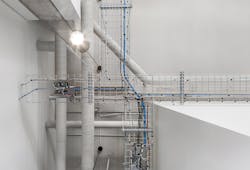Southwire embraces PoE lighting for new competitive Atlanta office space and beyond
Power over Ethernet (PoE) is a proven cost-saving technology that has advanced over the past two decades to power a wide range of connected devices over balanced twisted-pair network cabling, eliminating the need to run traditional 110/220 Volt AC power. It has become the primary means for powering everything from surveillance cameras and wireless access points (APs) to point-of-sale machines, digital displays, vending machines, and more.
PoE also provides additional cost savings and efficiency for now mainstream LED lighting systems—all while enabling a ubiquitous platform for connected IoT sensors and driving DC power distribution in sustainable smart buildings. The opportunity presented by PoE lighting did not go unnoticed by wire and cable producer Southwire when they expanded with a new hub at The Battery Atlanta.
Adopting emerging technology
Founded in 1950, Southwire has grown organically and through several acquisitions. The company now boasts more than 9,000 employees worldwide with manufacturing, service center, and office facilities across the U.S. and Canada, China, Mexico, and Central America. Southwire’s main corporate office is located about an hour outside Atlanta, Georgia, in Carrollton, along with its research and development center, MC cable plant, and other copper manufacturing, recycling, and milling operations. Southwire has also had a longtime presence in the metro Atlanta area with a Commuter Hub in Cobb County and The Spark innovation center on Georgia Tech’s campus.After the Commuter Hub building sold, Southwire signed a deal in 2022 for roughly 23,000 square feet of Class A satellite office space at The Battery Atlanta adjacent to Truist Park, home of the Atlanta Braves. This mixed-use development with retail, restaurants, entertainment, accommodations, and office space is considered a hotspot in the bustling Cumberland area of Atlanta at the intersection of I-75 and I-285. With many employees based in Atlanta and the metro area being ideal for attracting and retaining new talent—especially considering the company’s relationship with Georgia Tech Expansion—expansion in this area made perfect sense for Southwire.
Although commercial metal-clad (MC) copper building cable used in conventional AC-based LED lighting systems is a core part of their business, Southwire decided to implement emerging PoE lighting technology for the new space. The company had already been experimenting with the technology at The Spark innovation center, and the new space provided a real-world deployment opportunity.
“As a company, we’re always looking at emerging technologies that affect power delivery and might disrupt our core business. Deploying PoE lighting in our new space gives us a front seat to absorb and fully assess the technology,” says Charles Hume, Southwire’s director of emerging technologies. “Regular MC building wire isn’t going to disappear, but we want to be at the forefront and drive disruption rather than be disrupted.”
In addition to embracing new technology, Southwire selected PoE lighting due to its potential for additional energy and cost savings and the ability to improve building intelligence. The system helped Southwire achieve points towards their LEED Silver certification, reduce the amount of material used, and reduce installation costs.
“As a company, we are committed to reducing our carbon footprint and energy consumption. PoE lighting is more efficient because it eliminates the AC-DC conversion and heat associated with conventional LED lighting drivers. We are leveraging PoE lighting to acquire critical data about the space and integrate smart building capabilities,” said Hume. “Maintenance and installation costs are lower with nodes outside the fixtures and through low-voltage wiring and components. We also thought about material savings—copper is finite, and as cost goes up, PoE lighting can save a lot of metal in a building.” Category 6 twisted-pair cabling used to connect and power PoE lighting fixtures is about one-third the weight and half the diameter of 3-conductor, 12-AWG MC cable typically used in conventional LED lighting systems.
Partnering with experts
Southwire’s new office hub at The Battery Atlanta includes four conference rooms, a training room, 17 private offices, two huddle rooms, and nearly 14,000 square feet of open office space featuring an open ceiling concept. The diverse areas required a range of PoE lighting fixtures, including standard recessed panels, downlights, and various pendants. Controls and sensors for the PoE lighting system included touch-plate controls for dimming and a combination of occupancy, daylight, and passive infrared motion sensors. The project also included relays for desk outlets tied to the lighting control system to conserve energy when the space is unoccupied and during off-peak hours.Because the new space was a greenfield installation and Southwire didn’t have ample experience in designing and deploying PoE lighting, they decided to turn to the expertise of Sinclair Digital Services, Inc. Sinclair Digital is a full-service consulting, design/build, and project management firm specializing in Class 2 DC power infrastructure and PoE and known for projects like the all-PoE Sinclair Autograph Hotel in Fort Worth, Texas, and the Hotel Marcel, the nation’s first net-zero hotel in New Haven, Connecticut. The firm is also at the forefront of the DC power movement encompassing PoE, DC microgrids, battery energy storage, and emerging Class 4 fault-managed power systems that distribute safe, efficient DC power throughout buildings. Southwire is currently an active investor in Sinclair, and having a chance to partner on a project was exciting for both teams.
“We have a good relationship with Sinclair Digital, and while our PoE lighting project is smaller in scope than their other projects, we knew that collaborating with their experts would give us the learning experience we were looking for,” said Hume. “Plus, we understand their vision and are keenly interested in DC power infrastructure using new fault-managed power.”
Southwire recently demonstrated its interest in fault-managed power as a future sustainable technology by investing in VoltServer, inventor of Digital Electricity™ (DE) for distributing fault-managed power. As a part of the investment, Southwire will join Sinclair Digital and other technology providers as a strategic partner for VoltServer.
“At Southwire, we’re committed to being a leader in corporate sustainability, and this investment is a testament to those efforts,” said Norman Adkins, president of wire and cable and COO for Southwire. “VoltServer's offering fits squarely in our digital power focus, combining data and DC power to create a new format of low-loss electrical distribution. We're excited about the opportunities that this partnership will bring for Southwire, as we continue to discover, develop, and distribute strong and sustainable solutions that exceed the expectations of our stakeholders around the world."
Sinclair Digital designed the project with a single battery backup and centralized PoE switches in telecommunications spaces that deliver power and connectivity to the PoE lighting nodes connecting the fixtures. They also oversaw the entire project, including subcontracting North Carolina-based Superior Cabling Solutions for installation services and working closely with the architects from the firm ASD|SKY and other trades—all while ensuring the aesthetics met expectations for a Class A office space, showcasing Southwire products, and completing the project as quickly as possible.
"All of the cabling, from the PoE switches to the lighting nodes, was Southwire Category 6 cable, and we used their 18-gauge cable for connecting nodes to fixtures, relays, and wall controllers," says Aaron Rosas, director of design for Sinclair Digital. "Working within a short project schedule and open ceiling concept while ensuring the nodes and cabling looked neat and professional was challenging. One strategy we used was to leverage the cable tray as a mounting surface for the lighting nodes, grouping them throughout the space to maintain compliance with both cabling and aesthetic standards."Involving key stakeholders early in the design phase and ensuring good cooperation and communication with all trades is essential to a successful PoE lighting project. This helps knock down silos between trades. "The order of construction events can differ with PoE lighting, and as with any new technology, it can be challenging to educate all the trades on why you're doing what you're doing. We needed to make sure everyone got behind the PoE lighting technology, its implementation, and the leveraging of pathways," says Hume. "In the end, we were very pleased with the coordination, communication, and education provided by Sinclair Digital—it was a learning experience for all."
Rosas of Sinclair Digital concurs. "Because we were involved early, we could pass along instructions for temporary lighting and allow other trades to use the same pathways, which saved time and money. Other trades on the job had not seen a PoE lighting project before, so it generated a bit of interest," he says.
Achieving successful outcomes
Southwire's new office expansion at The Battery Atlanta achieved impressive results with LEED Silver certification, energy savings, and a reduced carbon footprint in line with their sustainability goals. The lighting power density of the new space calculates at 0.49 Watts (W)/ft2, which is 30% below the latest ASHRAE 90.1 requirement of 0.7 W/ft2 for tenant improvements in facilities up to 25,000 ft2. The company celebrated the opening with approximately 200 team members, customers, partners, and community leaders commemorating the occasion with a ribbon cutting, tours, networking, and a special guest appearance by Atlanta Braves mascot, Blooper.While Southwire's PoE lighting system didn't take advantage of all the possibilities, such as controlling lighting temperature and deploying IoT sensors beyond occupancy and daylight harvesting, Hume is confident they can add to the system over time. "We could have deployed additional sensors like people counting to get insights on space utilization. We also could have leveraged PoE for more than just powering and controlling lights, such as raising desks and integrating shades. But there's a lot we can add to the system in the future, and we're experimenting with the PoE lighting system at The Spark innovation center," he says. "Benchmarking is critical, and because it's new, we don't have a comparison. We are currently developing a plan for collecting and analyzing data, including considering deployments elsewhere for benchmarking."
A common challenge with PoE lighting is gaining buy-in from the architectural and mechanical, electrical and plumbing (MEP) community. That was not a problem with the Southwire project because Sinclair Digital engaged in the early design process and had an open dialog to bridge the gap with the architects. Cas Swope, a senior interior designer with the architectural firm ASD|SKY, agrees. "From a design standpoint, the PoE lighting system does everything we need it to do. From an engineering standpoint, it actually seemed to take the load off of the engineers, which is a good thing," he says. "We're seeing more projects move to PoE, and while this is the first one I've worked on, I would do it again—as long as it's integrated early and I have a partner like Sinclair Digital who fully understands the technology and can design and implement it alongside us."
Overall, everyone involved with the project is pleased with the outcome. "Everything looks great and works great. Even behind the scenes with the nodes and cables, it looks very impressive," says Hume. "PoE lighting is a great fit for Class A office space, and the bigger the space, the more savings and advantages it offers."
About the Author

Betsy Conroy
Betsy Conroy has spent the past three decades writing quality technical content and leveraging that content to launch impactful integrated marketing campaigns. She started her career as a technical and promotional writer for medical, security, and environmental corporations. In early 2000, she became an independent freelance writer, editor, and content consultant, focusing primarily on B2B manufacturers and associations in the electrical, networking, and telecommunications industries. Betsy frequently publishes content in a variety of industry publications on behalf of her clients and is also a contributing writer to Smart Buildings Technology Magazine. She was previously a monthly contributing writer to Cabling Installation & Maintenance Magazine and chief editor of BICSI News Magazine for five years where she was instrumental in bringing the publication from a newsletter status to that of a preeminent trade magazine and helping to launch BICSI’s premier publication, ICT Today.

Luis Suau
Luis has more than 40 years of industry experience, having previously worked as a technical leader in Cisco's IoT Business Unit where he was instrumental in developing Cisco's Digital Ceiling and Digital Building Solutions. As a longtime proponent of sustainability, Luis joined Sinclair Digital to pursue his passion for expanding the scope of digital building systems and DC-based infrastructure. Luis holds a BBA degree in management information systems from Florida International University.




